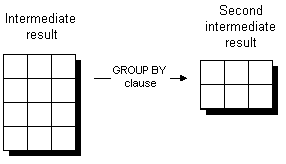This section uses the ROLLUP sub-clause of the GROUP BY clause in the explanation and example. For more information on the ROLLUP clause, see Using ROLLUP and CUBE.
Consider a single-table query of the following form:
SELECT select-list FROM table WHERE where-search-condition GROUP BY [ group-by-expression | ROLLUP (group-by-expression) ] HAVING having-search-condition
This query is executed in the following manner:
This generates an intermediate result that contains only some of the rows of the table.

This action generates an intermediate result with one row for each group as dictated by the GROUP BY clause. Each generated row contains the group-by-expression for each group, and the computed aggregate functions in the select-list and having-search-condition.

Subtotal rows computed as part of a ROLLUP operation are added to the result set.
Any rows from this second intermediate result that do not meet the criteria of the HAVING clause are removed at this point.
This action takes from step 3 only those columns that need to be displayed in the result set of the query—that is, it takes only those columns corresponding to the expressions from the select-list.

This process makes requirements on queries with a GROUP BY clause:
| Send feedback about this page via email or DocCommentXchange | Copyright © 2008, iAnywhere Solutions, Inc. - SQL Anywhere 11.0.0 |